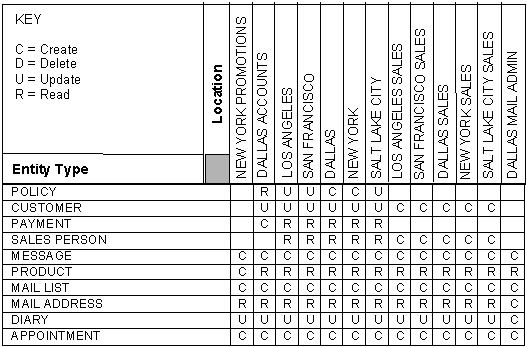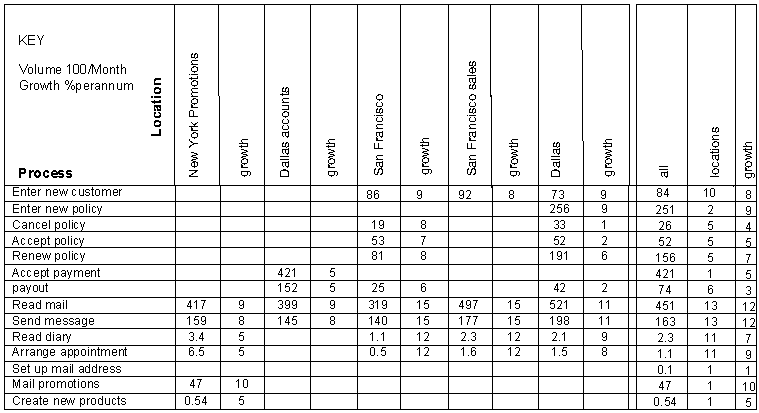

Analyzing Interactions › Analyzing Distribution › Performing Distribution Analysis
Performing Distribution Analysis
To analyze distribution, perform the following steps as needed:
Step 1 Identify Organizations and Locations
A location is a physical place at which activities of interest to the enterprise may be performed, either by the enterprise itself or by external organizational units.
- List the locations where processes in the business area are performed. As a starting point, use the locations identified in the Business Systems Architecture or the Technical Architecture.
- Occasionally, a business activity may be subcontracted and performed at a location belonging to another enterprise. For example, a warehouse would be of interest whether it is owned by the enterprise, or used by the enterprise but managed by a specialist supplier. Include locations that are external to the business if processes are performed or planned to be performed there.
- For reasons of competitive advantage, and to extend control of the value-chain, the enterprise may seek to support the activities of other enterprises at locations belonging to those other enterprises. Such locations may also be included in the analysis if the activities and their supporting data are added to the business model.
- A location does not necessarily correspond exactly to a physical address. For example, headquarters and a regional sales office of a company may share a postal address. A location need not even be fixed geographically. A ship or a car of a salesperson, especially with the telecommunications links of today, may be a perfectly acceptable location. A location is not an organizational unit, although it may sometimes share a name with a unit, for example, Southern Sales Office.
- There may be many locations that perform the same role, for example, sales offices, factories, and warehouses. The location type groups together those locations that perform similar roles and share broadly similar frequencies of activities and volumes of data. A location type is a classification of locations based on the similarity of their role or purpose, and of their level of activity.
- Identify the roles performed at locations and, if relevant, summarize similar locations together to form location types. If there are groupings already recognized by the business, for example, northern region or bulk warehouses, use them until significant variations suggest the need for subdivision.
- Record the number of locations known to exist for each location type and record user estimates or business planning assumptions of expected growth of locations of each type. Locations that serve a similar purpose but have markedly different process frequencies should not be grouped into a location type.
Step 2 Analyze Activity Distribution
Record what elementary processes are performed at which location, or location type, using a Process/Location Matrix such as the one shown in the following illustration.

- Record the distribution information by determining where the equivalent procedure is performed, or by obtaining the opinions of users on where it should be performed, if it is currently not done.
- If the enterprise has already decided to relocate a process, then its intended location is identified and its current location(s) and location types are recorded.
- When considering where processes should be performed, it may help to review any events that enable processes to determine at what location the business becomes aware that an event has taken place. This technique may be useful when the enterprise is considering relocating the performance of some activities, perhaps as part of re-engineering a business process.
- Business processes may be supported by more than one procedure. These procedures may occur at more than one location or location type over which the process is distributed at present.
- If a process currently has no equivalent procedure which is rare, then record its anticipated location.
- Omit from subsequent analysis any locations or location types that are not used by processes within the scope of analysis.
Step 3 Analyze Data Distribution
This is performed only if distributed data support for the business is part of the Technical Architecture, and if refinement of the data store distribution is a critical design issue.
- For each entity type and location/location type, determine the locations of processes that Create, Read, Update and Delete entities of the entity type.
- Create an Entity Type/Location Matrix, such as that shown in the following illustration. As starting points, use the Process/Entity Type Matrix (or the expected effects of each process) and the Process/Location Matrix.

Step 4 Summarize Volumetric Data
In this step, you record or estimate the frequency of execution of each elementary process at each location, or location type, using a Process Frequency Table such as the one in the following illustration.

In this table, the entries show process frequency, which is the number of times in a given period a process is performed at a location or location type.
- Examine the Process Frequency Table and the Entity Type/Location Matrix. Use the entity creation and deletion frequency to record or estimate the volumes of entity types expected to be included in data stores at each location or location type.
- Record the estimates in the entity volume table. In this table, the entries show entity volume: the number of entities of interest to a location or a business area.
An example is shown in the following illustration.

- Process frequencies and entity volumes are recorded as current figures. All the figures are based on the same time interval, for example, a month.
- Growth is extrapolated out to the planning horizon for the systems to be developed.
- The total of processes or entity types for all locations may not equal the total of individual locations, if some processes are performed, or entities are used, at more than one location.
- Record the number of locations of each type in which activities of the enterprise are performed. Together with any anticipated growth factor, this is documented as a property of the location type. Record the basis of any calculations and any assumptions made. Where there are no current figures take the best estimates of users.
Methods for assessing volumes and frequencies:
- When analyzing frequency, use any agreed upon business strategy for distribution and the Technical Architecture developed during planning to choose the appropriate level of analysis. Use the least detailed analysis that still satisfies the needs of planning and design.
- The frequency of a process that creates an entity may be derived from the volume of new entities observed or expected in the period.
- The frequency of a process that is triggered by an event is derived from the frequency of that event.
- The frequency of process executions may also be assessed using the optionality and cardinality of dependencies with other processes whose frequency is already known.
- The volume of entities of a type may be derived from information about the frequency of the processes that create and delete them, and the period of time for which entities are of interest to a location. For example, a warehouse is only interested in planned and recent deliveries, while a head office may need to analyze deliveries over a long period.
- Volumes and frequency may vary by time period, for example, the volume of orders taken may rise before a holiday period. Analysts are interested in maximum likely volumes and frequencies. For this reason, it is important to discover the expected growth. This may be derived by extrapolation from previous growth, based on assumptions connected with planned business developments, or affected by expected changes in the business environment.
- The number and growth of individual locations of each type have already been recorded. The total growth of volumes and frequencies out to the planning horizon can then be calculated by multiplication.
When likely changes in location or frequency are already known, a review of distribution stability may be usefully performed during distribution analysis, or may be performed separately as one aspect of stability analysis, which is covered in the chapter "Starting Object-Oriented Analysis."
Copyright © 2014 CA.
All rights reserved.
 
|
|





